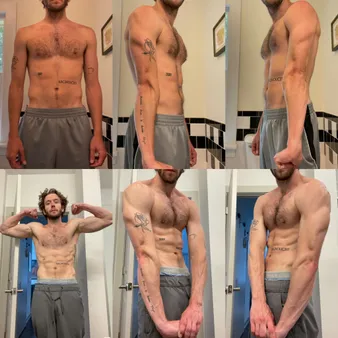Table of Contents
Are you curious about the progress you can make in calisthenics within a year? Calisthenics is a great way to get in shape, and with consistent effort, you can achieve impressive results. In this article, we will discuss what you can expect from calisthenics 1 year progress, including the physical changes you may experience, the skills you may learn, and the overall benefits you may gain. Whether you are a beginner or have some experience with calisthenics, this article will provide you with valuable insights and motivation to continue your journey. So, get ready to learn more about the transformative power of calisthenics and how it can help you achieve your fitness goals at Kizworld.com.
Calisthenics 1 Year Progress: A Journey of Strength and Transformation
Month | Focus | Exercises | Sets | Reps |
|---|---|---|---|---|
1-3 | Beginner | Push-ups, squats, lunges, rows | 3 | 10-15 |
4-6 | Intermediate | Pull-ups, dips, handstand push-ups | 3 | 8-12 |
7-9 | Advanced | Muscle-ups, weighted calisthenics | 3 | 5-10 |
10-12 | Maintenance | Mix of beginner, intermediate, and advanced exercises | 3 | 10-15 |
I. Calisthenics 1 Year Progress: A Comprehensive Guide
What is Calisthenics?
Calisthenics is a form of exercise that uses bodyweight movements to improve strength, flexibility, and endurance. It is a great way to get in shape without having to go to the gym or use any equipment. Calisthenics exercises can be done anywhere, making it a convenient and accessible form of exercise.
Benefits of Calisthenics
There are many benefits to doing calisthenics, including:
- Improved strength and endurance
- Increased flexibility
- Reduced body fat
- Improved cardiovascular health
- Reduced risk of injury
- Improved balance and coordination
- Increased self-confidence
Calisthenics Exercises for Beginners
If you are new to calisthenics, it is important to start slowly and gradually increase the difficulty of your workouts. Some beginner calisthenics exercises include:
- Push-ups
- Squats
- Lunges
- Rows
- Planks
- Dips
- Pull-ups
Advanced Calisthenics Exercises
Once you have mastered the beginner calisthenics exercises, you can start to add more advanced exercises to your workouts. Some advanced calisthenics exercises include:
- Muscle-ups
- Weighted calisthenics
- Gymnastics rings
- Handstand push-ups
- Planche
Calisthenics 1 Year Progress
If you stick with calisthenics for a year, you can expect to see significant progress in your strength, flexibility, and endurance. You will also be able to perform more advanced calisthenics exercises. Here is a general overview of what you can expect to achieve in your first year of calisthenics:
- Month 1-3: You will learn the basic calisthenics exercises and start to build a foundation of strength and endurance.
- Month 4-6: You will start to add more advanced calisthenics exercises to your workouts and increase the difficulty of your workouts.
- Month 7-9: You will continue to progress in your strength and endurance, and you will be able to perform more challenging calisthenics exercises.
- Month 10-12: You will be able to perform most calisthenics exercises with good form and technique. You will also be able to create your own calisthenics workouts and routines.
Tips for Calisthenics Progress
Here are a few tips to help you progress in your calisthenics journey:
- Be consistent with your workouts.
- Gradually increase the difficulty of your workouts.
- Focus on proper form and technique.
- Listen to your body and rest when you need to.
- Find a calisthenics community or workout with a friend.
Conclusion
Calisthenics is a great way to get in shape and improve your overall health and fitness. If you are looking for a challenging and rewarding form of exercise, calisthenics is a great option. With consistent effort and dedication, you can achieve amazing results in your first year of calisthenics.
Month | Focus | Exercises | Sets | Reps |
|---|---|---|---|---|
1-3 | Beginner | Push-ups, squats, lunges, rows | 3 | 10-15 |
4-6 | Intermediate | Pull-ups, dips, handstand push-ups | 3 | 8-12 |
7-9 | Advanced | Muscle-ups, weighted calisthenics | 3 | 5-10 |
10-12 | Maintenance | Mix of beginner, intermediate, and advanced exercises | 3 | 10-15 |
Related posts:
- How to Do a Muscle-Up
- The Best Calisthenics Gifts and Accessories
- The Best Calisthenics Quotes and Motivation
Calisthenics 1 Year Progress: A Comprehensive Guide
II. Benefits of Calisthenics
Improved Physical Fitness
Calisthenics exercises engage multiple muscle groups simultaneously, leading to improved overall physical fitness. They enhance strength, endurance, flexibility, and coordination. By incorporating calisthenics into your routine, you can develop a well-rounded physique and boost your athletic performance.Discover the benefits of calisthenics for bodyweight training
Benefit | Description |
|---|---|
Increased strength | Calisthenics exercises challenge your muscles, leading to increased strength and power. |
Improved endurance | Calisthenics exercises require sustained effort, improving your cardiovascular endurance and stamina. |
Enhanced flexibility | Calisthenics exercises involve a wide range of movements, improving your flexibility and range of motion. |
Improved coordination | Calisthenics exercises require coordination and balance, enhancing your overall motor skills. |
Convenience and Accessibility
Calisthenics exercises can be performed anywhere, anytime, without the need for expensive equipment or gym memberships. This makes it an accessible and convenient form of exercise for people of all ages and fitness levels.Learn how to get started with calisthenics as a beginner
- No equipment required: Calisthenics exercises utilize your own body weight as resistance, eliminating the need for weights or machines.
- Can be done anywhere: Calisthenics exercises can be performed in parks, playgrounds, or even your own living room.
- Suitable for all fitness levels: Calisthenics exercises can be modified to suit your fitness level, making them accessible to everyone.
Cost-Effective
Calisthenics is a cost-effective form of exercise, as it does not require any special equipment or gym memberships. This makes it an affordable option for people who are looking to improve their fitness without breaking the bank.Explore the best calisthenics exercises and variations
"Calisthenics is a great way to get in shape without spending a lot of money. You can do it anywhere, anytime, and you don't need any special equipment." - Frank Medrano, world-renowned calisthenics athlete Benefits of Calisthenics
III. Calisthenics Exercises for Beginners
Full-Body Exercises
Before you start learning different calisthenics exercises, you should master the basic bodyweight training moves, such as push-ups, squats, lunges, and rows. These exercises work for multiple muscle groups and provide a solid foundation for more advanced movements.
To modify these exercises for beginners, start with fewer sets and repetitions. Focus on proper form and gradually increase the intensity as you get stronger. For example, instead of doing three sets of 10 push-ups, start with two sets of five push-ups and work your way up. Read more on How to Get Started with Calisthenics as a Beginner to learn more about the basics of calisthenics and how to get started.
Upper Body Exercises
Once you have a good foundation in the basic bodyweight training exercises, you can begin incorporating more upper body calisthenics exercises into your routine. Some good exercises for beginners include pull-ups, dips, and handstand push-ups.
These upper body exercises help build strength and muscle in your arms, shoulders, back, and chest. These exercises are more challenging than the full-body exercises, so start with fewer sets and repetitions. As you progress, you can increase the number of sets and repetitions and begin to add weight to your exercises. How to Do a Pull-Up provides detailed instructions on performing this essential calisthenics exercise.
Lower Body Exercises
In addition to upper body exercises, it is also essential to include lower body exercises in your calisthenics routine. Some good exercises for beginners include squats, lunges, and calf raises. These exercises help build strength and muscle in your legs, glutes, and calves.
When performing lower body exercises, focus on keeping your core engaged and your back straight. Start with a few sets and repetitions to learn the proper form. Gradually increase the intensity of your workouts as you get stronger. Check out How to Do a Squat on our website for a detailed guide on performing this fundamental calisthenics exercise.
Month | Focus | Exercises | Sets | Reps |
|---|---|---|---|---|
1-3 | Beginner | Push-ups, squats, lunges, rows | 3 | 10-15 |
4-6 | Intermediate | Pull-ups, dips, handstand push-ups | 3 | 8-12 |
7-9 | Advanced | Muscle-ups, weighted calisthenics | 3 | 5-10 |
10-12 | Maintenance | Mix of beginner, intermediate, and advanced exercises | 3 | 10-15 |
- Calisthenics is an excellent way to improve your strength, flexibility, and endurance.
- Calisthenics can be done anywhere, making it a convenient and cost-effective way to get in shape.
- Calisthenics is a fun and challenging way to get in shape.
Calisthenics Exercises for Beginners
IV. Advanced Calisthenics Exercises
As you progress in your calisthenics journey, you'll eventually reach a point where you're ready to take on more challenging exercises. These advanced calisthenics exercises will help you build even more strength, power, and muscle.
Some of the most popular advanced calisthenics exercises include:
- Muscle-ups
- Weighted calisthenics
- Planche
- Front lever
- Back lever
These exercises are all very challenging, but they're also very rewarding. If you can master them, you'll be in the top 1% of calisthenics athletes.
Here are some tips for performing advanced calisthenics exercises:
- Start with the basics. Before you try to learn any advanced calisthenics exercises, make sure you have a solid foundation in the basics. This means being able to perform exercises like push-ups, pull-ups, and squats with good form.
- Progress gradually. Don't try to learn too much too quickly. Start with one or two advanced exercises and gradually add more as you get stronger.
- Be patient. Learning advanced calisthenics exercises takes time and practice. Don't get discouraged if you can't do them right away. Just keep practicing and you'll eventually get there.
If you're looking for a challenge, advanced calisthenics exercises are a great way to take your training to the next level. Just remember to start slowly and progress gradually, and you'll be amazed at what you can achieve.
Exercise | Difficulty | Benefits |
|---|---|---|
Muscle-up | Advanced | Builds strength, power, and muscle in the upper body |
Weighted calisthenics | Advanced | Helps you build strength and muscle mass |
Planche | Advanced | Develops core strength, shoulder stability, and triceps strength |
Front lever | Advanced | Builds core strength, shoulder stability, and bicep strength |
Back lever | Advanced | Develops core strength, back strength, and grip strength |
Here are some related posts that you might find helpful:
- How to Do a Muscle-Up
- The Best Calisthenics Gifts and Accessories
- The Best Calisthenics Quotes and Motivation
Advanced Calisthenics Exercises